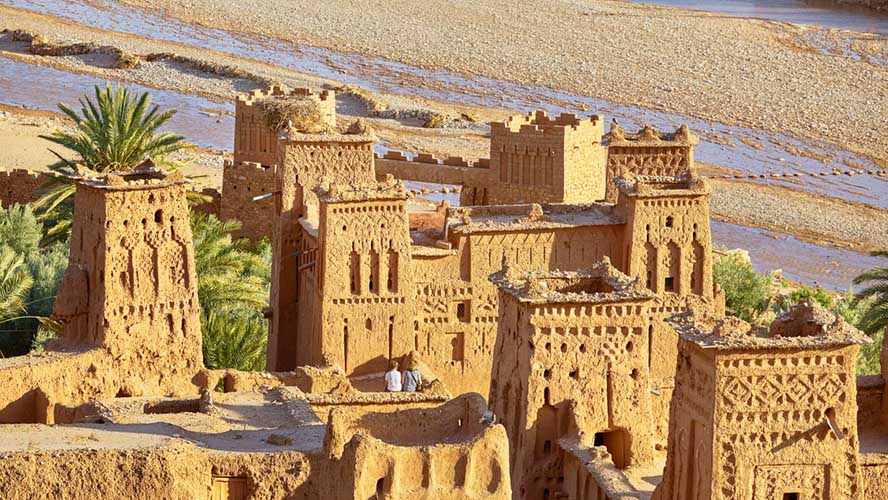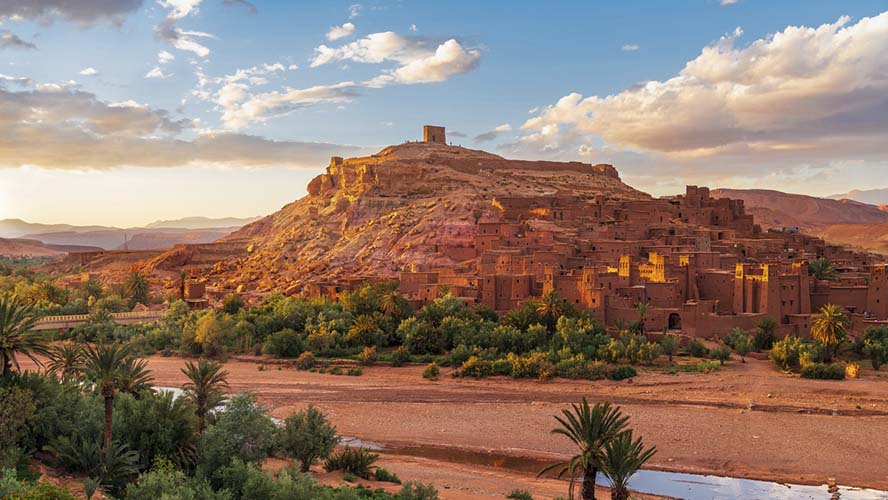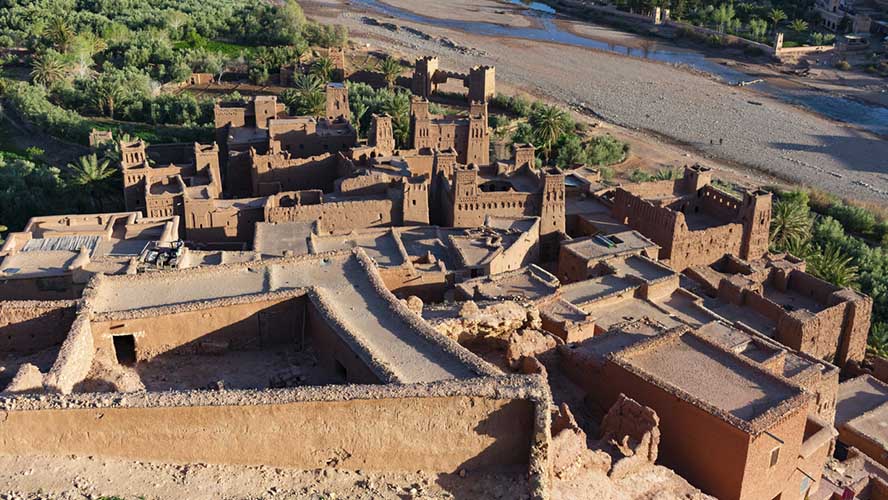Stay in Ait Ben Haddou or Continue to Dades
The jewel in the crown among the scores of kasbahs to be found in the south of Morocco is located 30 kilometres from Ouarzazate. On the edge of the desert, the adobe-built houses of Ait Ben Haddou's impressive ksar stand at the foot of a cliff, and evoke in the visitor a sense of having travelled back in time.
A ksar is a fortified settlement of Berber origin, with many kasbahs inside it. In north Africa, it is typically built from traditional materials such as adobe or wood. Ait Ben Haddou is Morocco's most famous ksar, and probably one of the country's most remarkable and fascinating monuments.
Stepping inside this stronghold is momentarily disorientating. The narrow streets and passages of this urban labyrinth twist around mostly uninhabited houses with several centuries of history behind them and which defy the passing of the years.
In common with other ksars, Ait Ben Haddou has provided the setting for many top feature films. As we shall see, its architecture provides a perfect set for films and series.
History of the Ait Ben Haddou ksar
The town is named in honour of its founder, Ben Haddou who, according to legend, established a tribe here in 757. It is believed that his tomb lies beneath the town. Construction of the present ksar dates from the seventeenth century, when the town gained strategic importance in north Africa.
The key to Ait Ben Haddou's importance is that it was a very important stop on the route of traders travelling between Marrakesh and the Sahara. Caravans transported gold, silver and spices on the trans-Saharan trade routes which for a thousand years linked the lands that are now Morocco, Mali, Ghana, Niger, and Sudan.
The citadel provided a place of refuge for these traders. With an inn, a mosque, a granary and other services, it was a place where they could stop off during the months-long journeys.

Buildings of Ait Ben Haddou
Ait Ben Haddou is the best-preserved kasbah complex and the best example of its type in Morocco, and in recognition of this, it was declared a World Heritage Site by UNESCO in 1987. But similar constructions are scattered across the whole of southern Morocco, forming what is known as the Route of the Thousand Kasbahs. From the city of Ouarzazate, the various valleys in the foothills of the Atlas mountains are dotted with these little oases.
Places such as the Dadès Valley and its famous gorge, with the kasbahs of N'Kob, the kasbahs of Amridil, and the palm grove of Skoura, are splendid examples, showing the importance of the ksars down the centuries. All these kasbahs are near Marrakesh, and it is well worth travelling from the imperial capital to visit them.
What to see in the Ait Ben Haddou ksar
What lies inside the Ait Ben Haddou ksar? In spite of its great age, as well as the fame that has come its way thanks to cinema, this fortified town is still inhabited by a few families who are determined to continue living within its walls.
This walled settlement is a veritable labyrinth of streets and adobe houses built on a hill around a citadel. To reach it from the new city, you need to cross a bridge over the river Ounila, although some people simply walk across as the river is very shallow.

General view of Ait Ben Haddou
There are three entrances to the ksar. Once inside, we can admire the various parts of the town. The part closest the river and the mosque was occupied by the more affluent inhabitants, and here the houses can be up to five storeys high. It is still possible to spot details such as these, although the place is almost deserted.
The walls still protect the complex of monuments. The kasbah's keep is a useful reference point for getting an idea of the scale of the place. The keep affords an unparalleled panorama of this desert land, where the monotony of the landscape is broken only by the peaks of the Atlas mountains.
One of the great features of the Ait Ben Haddou ksar (and which worked to its advantage in securing recognition by UNESCO) is the standard of preservation and authenticity which has characterised it right up to the present day. Its buildings, for example, have been maintained using original materials: adobe, earth, straw and wood. The use of cement and concrete is strictly forbidden here.

Ait Ben Haddou inside
Appearances in series and films
Who hasn't been to a real place that has been the setting for a film? The list is endless, and the Ait Ben Haddou ksar is now part of the history of cinema, both as a backdrop and as a character in many hugely successful Hollywood films.
It was in Ait Ben Haddou that Maximus Decimus Meridius (Russell Crowe) became a slave in front of a Roman coliseum (Gladiator). Here too, Daenerys Targaryen (Emilia Clarke) arrived at the gates of Yunkai to conquer the city and free the slaves (Game of Thrones). Decades earlier, T. E. Lawrence (Peter O'Toole) passed through here in Lawrence of Arabia.
Here are a few more examples from the huge list of films and series shot on location in Ait Ben Haddou:
- Lawrence of Arabia (1962)
- Sodom and Gomorrah (1963)
- Jesus of Nazareth (1977)
- The Jewel of the Nile (1985)
- The Living Daylights (1987)
- The Last Temptation of Christ (1988)
- The Mummy (1999)
- Gladiator (2000)
- Alexander the Great (2004)
- The Kingdom of Heaven (2005)
- Babel (2006)
- Prince of Persia (2010)
- Game of Thrones (2011)
- Queen of the Desert (2015)
Source: https://www.barcelo.com/guia-turismo/en/morocco/marrakech/things-to-do/ait-ben-haddou/
0 Response to "Stay in Ait Ben Haddou or Continue to Dades"
Post a Comment